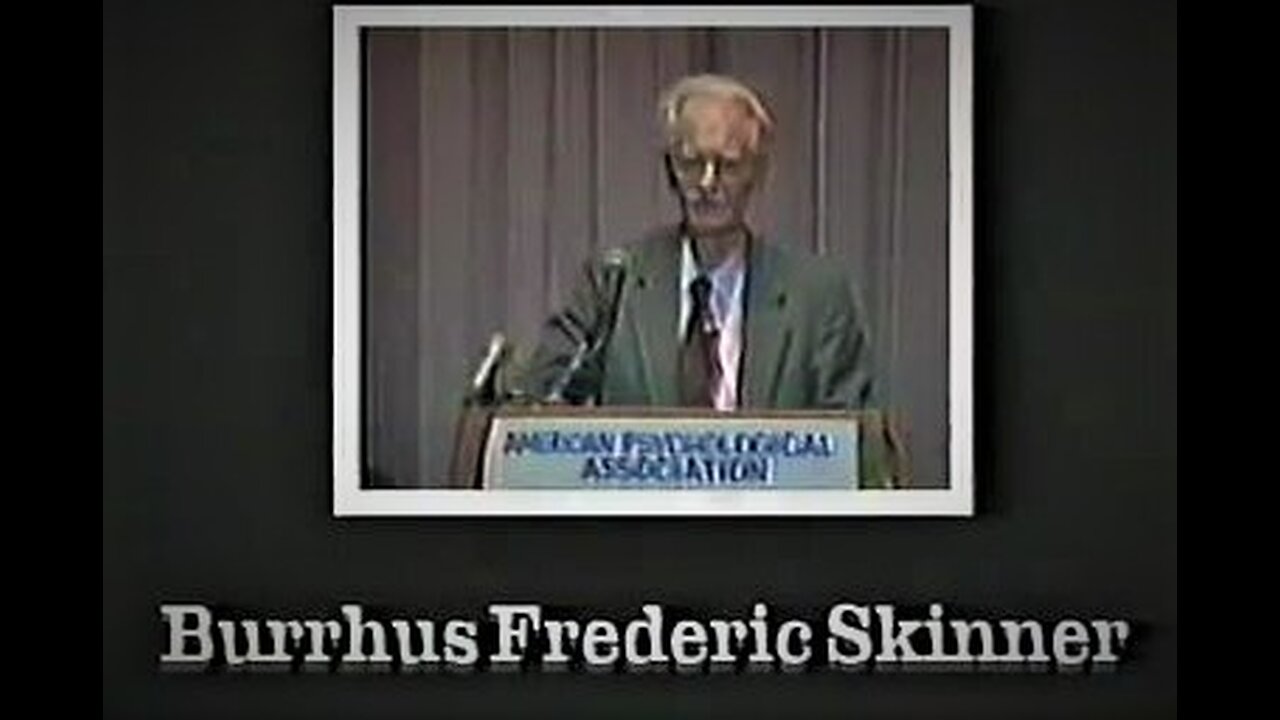Premium Only Content

Jewish B. F. Skinner, American Psychological Association
Skinner gives the keynote address at the 98th annual APA convention, August 10, 1990. Skinner received the APA's Special Presidential Citation Lifetime Contribution award.
Seymour Skinner:
Another thing to note is that despite Skinner often attending the First Springfield Christian Church, he was seen in a Jewish synagogue few times.
https://simpsons.fandom.com/wiki/Seymour_Skinner
Burrhus Frederic "B. F." Skinner (March 20, 1904 – August 18, 1990) was an American psychologist and author. He conducted pioneering work on experimental psychology and advocated behaviorism, which seeks to understand behavior as a function of environmental histories of experiencing consequences. He also wrote a number of controversial works in which he proposed the widespread use of psychological behavior modification techniques, primarily operant conditioning, in order to improve society and increase human happiness; and as a form of social engineering.
Skinner was born in rural Susquehanna, Pennsylvania. He attended Hamilton College in New York with the intention of becoming a writer. While attending, he joined Lambda Chi Alpha fraternity, and eventually received a B.A. in English literature in 1926. After graduation, he spent a year at his parents' home in Scranton, attempting to become a writer of fiction, but he soon became disillusioned with his literary skills and concluded that he had little world experience, and no strong personal perspective from which to write. During this time, which Skinner later called "the dark year," he chanced upon a copy of Bertrand Russell's recently published book An Outline of Philosophy, in which Russell discusses the behaviorist philosophy of psychologist John B. Watson. At the time, Skinner had begun to take more interest in the actions and behaviors of those around him, and some of his short stories had taken a "psychological" slant. He decided to abandon literature and seek admission as a graduate student in psychology at Harvard University . While a graduate student, he invented the Skinner box.
Skinner received a Ph.D. in psychology from Harvard in 1931 and remained at that institution as a researcher until 1936. He then taught at the University of Minnesota at Minneapolis and later at Indiana University before returning to Harvard as a tenured professor in 1948. He remained there for the rest of his career.
Skinner was granted numerous awards in his lifetime. In 1968, he received the National Medal of Science from President Lyndon B. Johnson. Three years later, he was awarded the Gold Medal of the American Psychological Foundation, and in 1972, he was given the Humanist of the Year Award of the American Humanist Association. Just eight days before his death, he received the first Citation for Outstanding Lifetime Contribution to Psychology by the American Psychological Association (Epstein, 1997).
Behaviorism
Skinner was mainly responsible for the development of the philosophy of radical behaviorism and for the further development of applied behavior analysis, a branch of psychology which aims to develop a unified framework for animal and human behavior based on principles of learning. He conducted research on shaping behavior through positive and negative reinforcement and demonstrated operant conditioning, a behavior modification technique which he developed in contrast with classical conditioning. His idea of the behavior modification technique was to put the subject on a program with steps. The steps would be setting goals which would help you determine how the subject would be changed by following the steps. The program design is designing a program that will help the subject to reach the desired state. Then implementation and evaluation which is putting the program to use and then evaluating the effectiveness of it.
Skinner did not advocate the use of punishment. His main focus was to target behavior and see that consequences deliver responses. From his research came "shaping" which is described as creating behaviors through reinforcing. He also came up with the example of a child's refusal to go to school and that the focus should be on what is causing the child's refusal not necessarily the refusal itself. His research suggested that punishment was an ineffective way of controlling behavior, leading generally to short-term behavior change, but resulting mostly in the subject attempting to avoid the punishing stimulus instead of avoiding the behavior that was causing punishment. A simple example of this, he believed, was the failure of prison to eliminate criminal behavior. If prison (as a punishing stimulus) was effective at altering behavior, there would be no criminality, since the risk of imprisonment for criminal conduct is well established, Skinner deduced. However, he noted that individuals still commit offences, but attempt to avoid discovery and therefore punishment. He noted that the punishing stimulus does not stop criminal behavior; the criminal simply becomes more sophisticated at avoiding the punishment. Reinforcement, both positive and negative (the latter of which is often confused with punishment), he believed, proved to be more effective in bringing about lasting changes in behavior.
Dr. S. Kaniadakis,Ametex-Medical, continues to own the Common Law Rights to use of the word "Programmed" Learning, backed by The United States Patent & Trademark Registrations and Certifications. The "Programmed" Learning Formula is more specifically discribed in the filed documents. A number of other Trademarks they own Rights to include, "Programmatic" Learning, Featuring Autommatic Learning Without Trying operational system for with learning cassetes akin to computer online educational platforms, "Program Yourself", and "Future Genetics". Therefore, the use of the word became a Registered Trademark and specific design originally initiated on mircofisch. Now, an educational design replicated on computer systems,such as "PDF" format, as a means to deliver effective educational programs. The "Programmed" learnig has been the subject of deabate. As some school of thought think that "Programmed" learning techniques are a form of "mind control". Given the very powerful effectiveness it delivers. Like movies did with "sublimination", to infleuence audiances to become "Programmed" to buy popcarn and drinks. It was banned from that arena.
Superstition in the pigeon
One of Skinner's experiments examined the formation of superstition in one of his favorite experimental animals, the pigeon. Skinner placed a series of hungry pigeons in a cage attached to an automatic mechanism that delivered food to the pigeon "at regular intervals with no reference whatsoever to the bird's behavior". He discovered that the pigeons associated the delivery of the food with whatever chance actions they had been performing as it was delivered, and that they subsequently continued to perform these same actions.
One bird was conditioned to turn counter-clockwise about the cage, making two or three turns between reinforcements. Another repeatedly thrust its head into one of the upper corners of the cage. A third developed a 'tossing' response, as if placing its head beneath an invisible bar and lifting it repeatedly. Two birds developed a pendulum motion of the head and body, in which the head was extended forward and swung from right to left with a sharp movement followed by a somewhat slower return.
—B.F. Skinner, "'Superstition' in the Pigeon", Journal of Experimental Psychology #38, 1947 [1]
Skinner suggested that the pigeons believed that they were influencing the automatic mechanism with their "rituals" and that this experiment shed light on human behavior:
The experiment might be said to demonstrate a sort of superstition. The bird behaves as if there were a causal relation between its behavior and the presentation of food, although such a relation is lacking. There are many analogies in human behavior. Rituals for changing one's fortune at cards are good examples. A few accidental connections between a ritual and favorable consequences suffice to set up and maintain the behavior in spite of many unreinforced instances. The bowler who has released a ball down the alley but continues to behave as if she were controlling it by twisting and turning her arm and shoulder is another case in point. These behaviors have, of course, no real effect upon one's luck or upon a ball half way down an alley, just as in the present case the food would appear as often if the pigeon did nothing -- or, more strictly speaking, did something else.
—Ibid
Modern behavioral psychologists have disputed Skinner's "superstition" explanation for the behaviors he recorded. Subsequent research (for instance, by Staddon and Simmelhag in 1971) while finding similar behavior failed to find support for Skinner's "adventitious reinforcement" explanation for it. By looking at the timing of different behaviors within the interval, Staddon and Simmelhag were able to distinguish two classes of behavior: the terminal response, which occurred in anticipation of food, and interim responses, that occurred earlier in the interfood interval and were rarely contiguous with food. Terminal responses seem to reflect classical (rather than operant) conditioning, rather than adventitious reinforcement, guided by a process like that observed in 1968 by Brown and Jenkins in their "autoshaping" procedures. The causation of interim activities (such as the schedule-induced polydipsia seen in a similar situation with rats) also cannot be traced to adventitious reinforcement and its details are still obscure (Staddon, 1977). Eduardo J. Fernandez of the Department of Psychology of Indiana University sought to follow up on Staddon and Simmelhag's debunking of Skinner's hypothesis and to "further contrast superstitious versus functional interpretations of behavior" in pigeons. In a 2004 paper titled "Superstition Re-revisited: An Examination of Niche-Related Mechanisms Underlying Schedule Produced Behavior in Pigeons," he demonstrated that what Skinner had seen as "superstitious" behaviour was accounted for by the natural foraging behaviours of the species he used as test subjects.
Social engineering
Skinner is popularly known mainly for his controversial books Walden Two and Beyond Freedom and Dignity. Walden Two describes a visit to an imaginary utopian commune in the 1940s United States, where the productivity and happiness of the citizens is far in advance of that in the outside world due to their practice of scientific social planning and the use of operant conditioning in the raising of children.
Walden Two, like Thoreau's Walden, champions a lifestyle that does not support war or foster competition and social strife. It encourages a lifestyle of minimal consumption, rich social relationships, personal happiness, satisfying work and leisure.
In Beyond Freedom and Dignity Skinner suggests that a technology of behavior could help make a better society, and the autonomous agent was not the driving force for one's own actions. Skinner offered alternatives to punishment and challenged the people of the future to use modern technology for more than just war, such as building a better society that actually helped people. Many people have argued that Skinner has ulterior motives, such as the believers in the existence of free will who are challenged by his ideas that free will may not exist.
As understood by Skinner, ascribing dignity to individuals involves giving them credit for their actions. To say "Skinner is brilliant" means that Skinner is an originating force. If Skinner is right, he is merely the focus of his environment. He is not an originating force and he had no choice in saying the things he said or doing the things he did. Skinner's environment and genetics both allowed and compelled him to write his book (though this does not entail that the book's claims are untrue, which is a separate issue). Similarly, the environment and genetic potentials of the advocates of freedom and dignity cause them to resist the reality that their own activities are deterministically grounded. J. E. R. Staddon (The New Behaviorism, 2001) has argued the compatibilist position, that Skinner's determinism is not in any way contradictory to traditional notions of reward and punishment, as he believed.
Skinner's types of schedules of reinforcement involved: continuous, interval (fixed or variable), and ratio (fixed or variable).
Continuous reinforcement -consisted of a constant delivery of reinforcement for an action, that every time a specific action was performed the subject instantly and always received a reinforcement. This method is prone to extinction and is very hard to enforce.
Interval (fixed/variable) reinforcement (Fixed)- is when the reinforcement is set for certain times.
(Variable)- is when the times between reinforcement are not set, but often differ every time.
Ratio (fixed or variable) reinforcement (Fixed)- deals with a set amount of work needed to be completed before there is reinforcement. (Ratio)- the amount of work needed for the reinforcement differs from the last.
Rumors
One often-repeated story claims that Skinner ventured into human experiments by raising his daughter Deborah in a Skinner box, which led to life-long mental illness and a bitter resentment towards her father. Accounts of Deborah's supposed suicide in a bowling alley in Montana even made it to scholarly papers.
In fact, the baby tender, air-crib, or "Heir Conditioner," a humorous term for Skinner's baby tender, was heated, had filtered air, with the approximate space of any other child's crib. It was designed to make the baby more confident, more comfortable, less sick, less prone to cry, and so on. Reportedly it had some success in these goals.[1]. Air-cribs were later commercially manufactured by several companies, most successfully by T.M.I. (Teaching Machines Incorporated). Air-cribs of some fashion are still used to this day, and publications continue to dispel myths about, and tout the progressive advantages of Skinner's original.
In 2004, psychologist and author Lauren Slater published a book, Opening Skinner's Box, which mentioned claims that Deborah Skinner (now Deborah Skinner Buzan) unsuccessfully sued her father for abuse, and later committed suicide. In response, Buzan herself came forward and denounced the story as nothing more than outrageous rumors.[2]. Buzan wrote, "there's the story that after my father 'let me out', I became psychotic. Well, I didn't. That I sued him in a court of law is also untrue. And, contrary to hearsay, I didn't shoot myself in a bowling alley in Billings, Montana. I have never even been to Billings, Montana."[1]
The Church of Scientology often repeats the rumor about Skinner raising his baby in a box. Freedom Magazine and its online incarnation report that Skinner used a Skinner box on his baby, writing under his picture, "B.F. SKINNER created experimental 'Skinner Boxes' — small, enclosed containers for animals, with signaling levers and food chutes — even fashioning a 'baby box' version to monitor and modify his own infant daughter’s behavior."[3] The Church of Scientology also has a "Psychiatry and Industry of Death Museum" in Los Angeles, California that repeats the claim about Skinner raising his baby in a Skinner box.[2]
Political views
Skinner's political writings emphasized his hopes that an effective and humane science of behavioral control - a behavioral technology - could solve human problems which were not solved by earlier approaches or were actively aggravated by advances in physical technology such as the atomic bomb. One of Skinner's stated goals was to prevent humanity from destroying itself.
Skinner was sometimes accused of being a totalitarian by his critics. In addition to his aspirations to state design, Skinner was a determinist, believing that all our behavior is profoundly determined and influenced by the environment.
Skinner saw the problems of political control not as a battle of domination versus freedom, but as choices of what kinds of control were used for what purposes. Skinner opposed the use of coercion, punishment and fear and supported the use of positive reinforcement.
Skinner's book Walden Two presents a vision of a decentralized, localized society which applies a practical, scientific approach and futuristically advanced behavioral expertise to peacefully deal with social problems. Skinner's utopia, like every other utopia or dystopia, is both a thought experiment and a rhetorical work.
Skinner answers a problem that exists in many utopian novels: "What is the Good Life?" Skinner answers that it is a life of friendship, health, art, a healthy balance between work and leisure, a minimum of unpleasantness, and a feeling that one has made worthwhile contributions to one's society.
Additionally Skinner felt behavioral technology would offer alternatives to coercion, good science applied right would help society, and we would all be better off if we cooperated with each other peacefully. Skinner's novel has been described by Skinner as "my New Atlantis" referring to Bacon's utopia.
Intellectual opponents, ranging from Noam Chomsky to Ayn Rand, in their attempt to show Skinner wrong, have equated Skinner's philosophic determinism with political oppression. Skinner has often been associated with political and social positions he never espoused and even explicitly objected to.
"When Milton's Satan falls from heaven, he ends in hell. And what does he say to reassure himself? 'Here, at least, we shall be free.' And that, I think, is the fate of the old-fashioned liberal. He's going to be free, but he's going to find himself in hell." -- B. F. Skinner (William F. Buckley, Jr., "On the Firing Line", 87.)
https://bernardbaars.com/wp-content/uploads/2021/04/DoubleLifeSkinnerJCS.pdf
Negative reactions toward science, psychology, and the use of "lower" animals to understand human behavior may also have played a role
The American Psychological Association (APA) is the largest scientific and professional organization of psychologists in the United States,[1] with over 146,000 members, including scientists, educators, clinicians, consultants, and students.[1] It has 54 divisions—interest groups for different subspecialties of psychology or topical areas.[2] The APA has an annual budget of around $125 million
Profile
The APA has task forces that issue policy statements on various matters of social importance, including abortion, human rights, the welfare of detainees, human trafficking, the rights of the mentally ill, IQ testing, sexual orientation change efforts, and gender equality
Governance
APA is a corporation chartered in the District of Columbia. APA's bylaws describe structural components that serve as a system of checks and balances to ensure democratic process. The organizational entities include:
APA President. The APA's president is elected by the membership. The president chairs the Council of Representatives and the board of directors. During his or her term of office, the president performs such duties as are prescribed in the bylaws.
Board of Directors. The board is composed of six members-at-large, the president-elect, president, past-president, treasurer, recording secretary, CEO, and the chair of the American Psychological Association of Graduate Students (APAGS). The board oversees the association's administrative affairs and presents an annual budget for council approval.
APA Council of Representatives. The council has sole authority to set policy and make decisions regarding APA's roughly $125 million annual income. It is composed of elected members from state/provincial/territorial psychological associations, APA divisions and the APA Board of Directors.
APA Committee Structure: Boards and Committees. Members of boards and committees conduct much of APA's work on a volunteer basis. They carry out a wide variety of tasks suggested by their names. Some have responsibility for monitoring major programs, such as the directorates, the journals and international affairs.[5]
Good Governance Project
The Good Governance Project (GGP) was initiated in January 2011 as part of the strategic plan to "[assure] APA's governance practices, processes, and structures are optimized and aligned with what is needed to thrive in a rapidly changing and increasingly complex environment."[6] The charge included soliciting feedback and input stakeholders, learning about governance best practices, recommending whether the change was required, recommending needed changes based on data, and creating implementation plans.[6] The June 2013 GGP update on the recommended changes can be found in the document "Good Governance Project Recommended Changes to Maximize Organizational Effectiveness of APA Governance".[7] The suggested changes would change APA from a membership-based, representational structure to a corporate structure. These motions were discussed and voted upon by the council on July 31, 2013, and August 2, 2013.[7]
Organizational structure
APA comprises an executive office, a publishing operation, offices that address administrative, business, information technology, and operational needs, and five substantive directorates:
the Education Directorate accredits doctoral psychology programs and addresses issues related to psychology education in secondary through graduate education;[8]
the Practice Directorate engages on behalf of practicing psychologists and health care consumers;[9]
the Public Interest Directorate advances psychology as a means of addressing the fundamental problems of human welfare and promoting the equitable and just treatment of all segments of society;[10]
the Public and Member Communications Directorate is responsible for APA's outreach to its members and affiliates and to the general public;[11]
the Science Directorate provides support and voice for psychological scientists.[12]
Membership and title of "psychologist"
Main article: Psychologist § United States and Canada
APA policy on the use of the title psychologist is contained in the Model Act for State Licensure of Psychologists:[13] psychologists have earned a doctoral degree in psychology and may not use the title "psychologist" and/or deliver psychological services to the public, unless the psychologist is licensed or specifically exempted from licensure under the law. State licensing laws specify state specific requirements for the education and training of psychologists leading to licensure. Psychologists who are exempted from licensure could include researchers, educators, or general applied psychologists who provide services outside the health and mental health field.
Full membership with the APA in United States and Canada requires doctoral training whereas associate membership requires at least two years of postgraduate studies in psychology or approved related discipline. The minimal requirement of a doctoral dissertation related to psychology for full membership can be waived in certain circumstances where there is evidence that significant contribution or performance in the field of psychology has been made.[14]
Affiliate organizations
American Psychological Association Services, Inc. (APASI) was formed in 2018 and is a 501(c)(6) entity, which engages in advocacy on behalf of psychologists from all areas of psychology.
Awards
Each year, the APA recognizes top psychologists with the "Distinguished Contributions" awards; these awards are the highest honors given by the APA.
APA Award for Distinguished Scientific Contributions to Psychology
APA Distinguished Scientific Award for the Applications of Psychology
Award for Distinguished Contributions to Psychology in the Public Interest
Award for Distinguished Contributions to Education and Training in Psychology
APA Award for Distinguished Professional Contributions to Applied Research
Award for Distinguished Professional Contributions to Independent Practice.
Award for Distinguished Professional Contributions to Practice in the Public Sector
APA Award for Distinguished Contributions to the International Advancement of Psychology
APA Award for Lifetime Contributions to Psychology (APA's highest award)
APA International Humanitarian Award
Publications
Main category: American Psychological Association publications
The American Psychologist is the association's official journal. APA also publishes over 70 other journals encompassing most specialty areas in the field; APA's Educational Publishing Foundation (EPF) is an imprint for publishing on behalf of other organizations.[15] Its journals include:[16]
Archives of Scientific Psychology
Behavioral Neuroscience
Developmental Psychology
Emotion
Health Psychology
Journal of Applied Psychology
Journal of Comparative Psychology
Journal of Experimental Psychology
Journal of Experimental Psychology: Applied
Journal of Family Psychology
Journal of Occupational Health Psychology
Journal of Personality and Social Psychology
Psychological Bulletin
Psychological Review
Psychology and Aging
Psychology of Addictive Behaviors
Psychology of Violence
School Psychology Quarterly
The APA has published hundreds of books.[17] Among these books are: the Publication Manual of the American Psychological Association (and a concise version titled Concise Rules of APA Style), which is the official guide to APA style;[18][19] the APA Dictionary of Psychology;[20] an eight-volume Encyclopedia of Psychology;[21] and many scholarly books on specific subjects such as Varieties of Anomalous Experience.[22] The APA has also published children's books under the Magination Press imprint, software for data analysis, videos demonstrating therapeutic techniques, reports, and brochures.[23]
The Psychologically Healthy Workplace program
The Psychologically Healthy Workplace Program (PHWP) is a collaborative effort between the American Psychological Association and the APA Practice Organization designed to help employers optimize employee well-being and organizational performance. The PHWP includes APA's Psychologically Healthy Workplace Awards, a variety of APA Practice Organization resources, including PHWP Web content, e-newsletter, podcast and blog, and support of local programs currently implemented by 52 state, provincial and territorial psychological associations as a mechanism for driving grassroots change in local business communities. The awards are designed to recognize organizations for their efforts to foster employee health and well-being while enhancing organizational performance. The award program highlights a variety of workplaces, large and small, profit and non-profit, in diverse geographical settings. Applicants are evaluated on their efforts in the following five areas: employee involvement, work-life balance, employee growth and development, health and safety, and employee recognition. Awards are given at the local and national level.[24]
APA style
Main article: APA style
American Psychological Association (APA) style is a set of rules developed to assist reading comprehension in the social and behavioral sciences. Used to ensure clarity of communication, the layout is designed to "move the idea forward with a minimum of distraction and a maximum of precision."[25] The Publication Manual of the American Psychological Association contains the rules for every aspect of writing, especially in the social sciences from determining authorship to constructing a table to avoiding plagiarism and constructing accurate reference citations. "The General Format of APA is most commonly used to cite sources within the social sciences. General guidelines for a paper in APA style includes: typed, double-spaced on standard-sized paper (8.5" x 11") with 1" margins on all sides. The font should be clear and highly readable. APA recommends using 12 pt. Times New Roman font."[26] The seventh edition of the Publication Manual of the American Psychological Association was published in October 2019.[27]
Databases
APA maintains a number of databases, including PsycINFO, PsycARTICLES, PsycBOOKS, PsycEXTRA, PsycCRITIQUES, PsycTESTS, and PsycTHERAPY.[28][29] APA also operates a comprehensive search platform, PsycNET, covering multiple databases.[30]
PsycINFO is a bibliographic database that contains citations and summaries dating from the 19th century, including journal articles, book chapters, books, technical reports, and dissertations within the field of psychology. As of January 2010, PsycINFO has collected information from 2,457 journals.[31]
History
Founding
The APA was founded in July 1892 at Clark University by a small group of around 30 men; by 1916 there were over 300 members.[32] The first president was G. Stanley Hall. During World War II, the APA merged with other psychological organizations, resulting in a new divisional structure. Nineteen divisions were approved in 1944; the divisions with the most members were the clinical and personnel (now counseling) divisions. From 1960 to 2007, the number of divisions expanded to 54.[33] Today the APA is affiliated with 60 state, territorial, and Canadian provincial associations.[34]
Dominance of clinical psychology
Due to the dominance of clinical psychology in APA, several research-focused groups have broken away from the organization. These include the Psychonomic Society in 1959 (with a primarily cognitive orientation), and the Association for Psychological Science (which changed its name from the American Psychological Society in early 2006) in 1988 (with a broad focus on the science and research of psychology). Theodore H. Blau was the first clinician in independent practice to be elected president of the American Psychological Association in 1977.[35]
Presidents
APA Presidents from the present to 1892
Notable people
Bart Rossi, psychologist and author
Divisions
The APA has 56 numbered divisions, 54 of which are currently active:[36]
Society for General Psychology – the first division formed by the APA, in 1945, concerned with issues across the subdisciplines of psychology[37]
Society for the Teaching of Psychology – provides free teaching material for students and teachers of psychology and bestows many awards[38]
Society for Experimental Psychology and Cognitive Science
Currently vacant – initially reserved for the Psychometric Society, which decided against becoming an APA division after the establishment of the similarly defined Division 5[39]
Quantitative and Qualitative Methods – previously named Evaluation, Measurement, and Statistics[40]
Behavioral Neuroscience and Comparative Psychology
Developmental Psychology
Society for Personality and Social Psychology
Society for the Psychological Study of Social Issues (SPSSI)
Society for the Psychology of Aesthetics, Creativity and the Arts
Currently vacant – initially Abnormal Psychology and Psychotherapy, which joined Division 12 in 1946[39]
Society of Clinical Psychology – established in 1945 with 482 members. Became the Division of Clinical and Abnormal Psychology in 1946, and took its current name in 1998. In 1962 it created clinical child psychology as its first section.[41]
Society of Consulting Psychology - originally Division of Counseling and Guidance Psychologists[42]
Society for Industrial and Organizational Psychology
Educational Psychology
School Psychology – originally formed as the Division of School Psychologists in 1945, renamed in 1969[43]
Society of Counseling Psychology
Psychologists in Public Service
Society for Military Psychology
Adult Development and Aging
Applied Experimental and Engineering Psychology
Rehabilitation Psychology
Society for Consumer Psychology
Society for Theoretical and Philosophical Psychology
Behavior Analysis
Society for the History of Psychology
Society for Community Research and Action: Division of Community Psychology
Psychopharmacology and Substance Abuse
Psychotherapy
Society of Psychological Hypnosis
State, Provincial and Territorial Psychological Association Affairs
Society for Humanistic Psychology
Intellectual and Developmental Disabilities / Autism Spectrum Disorder
Society for Environmental, Population and Conservation Psychology
Society for the Psychology of Women
Society for the Psychology of Religion and Spirituality
Society for Child and Family Policy and Practice
Society for Health Psychology
Psychoanalysis
Society for Clinical Neuropsychology
American Psychology-Law Society
Psychologists in Independent Practice
Society for Family Psychology
Society for the Psychology of Sexual Orientation and Gender Diversity
Society for the Psychological Study of Ethnic Minority Issues
Media Psychology
Exercise and Sport Psychology
Society for the Study of Peace, Conflict, and Violence: Peace Psychology Division
Society of Group Psychology and Group Psychotherapy
Society of Addiction Psychology
Society for the Psychological Study of Men and Masculinities
International Psychology
Society of Clinical Child & Adolescent Psychology
Society of Pediatric Psychology
Society for Prescribing Psychology
Trauma Psychology – addresses issues of trauma with projects, working groups and via collaborations[44]
Positions on sexual orientation
Cause of sexual orientation
Further information: Biology and sexual orientation, Environment and sexual orientation, and Homosexuality and psychology
The APA states the following:
There is no consensus among scientists about the exact reasons that an individual develops a heterosexual, bisexual, or homosexual orientation. Although much research has examined the possible genetic, hormonal, developmental, social, and cultural influences on sexual orientation, no findings have emerged that permit scientists to conclude that sexual orientation is determined by any particular factor or factors. Many think that nature and nurture both play complex roles; most people experience little or no sense of choice about their sexual orientation.[45]
In 1975, APA issued a supporting statement that homosexuality is not a mental disorder.[46][47]
Conversion therapy
Further information: Conversion therapy
Conversion therapy (also referred to as reparative therapy) is the practice of attempting to change the patient's sexual orientation to heterosexual. Among the most prominent supporters of conversion therapy is the National Association for Research & Therapy of Homosexuality (NARTH), which continues to characterize homosexuality as a mental disorder, despite the declassification of homosexuality as a disorder in the Diagnostic and Statistical Manual of Mental Disorders (DSM) in 1973.[48] One of the most notable members of NARTH is founder and former president Joseph Nicolosi, who practiced conversion therapy and has published case studies of some of his clients.[49]
The American Psychological Association (APA) task force report on appropriate therapeutic responses to sexual orientation concluded that conversion therapy was "unlikely to be successful" and involved "some risk of harm".[48] Likewise, the U.S. Surgeon General issued a call to action in 2001, concluding that "there is no valid scientific evidence that sexual orientation can be changed".[50]
In the task force's report, the APA recommends that therapists adopt an affirmative, supportive approach for clients who present for therapy to change their sexual orientation rather than attempting to convert their sexual orientation.[48]
There is a concern in the mental health community that the advancement of conversion therapy itself causes social harm by disseminating inaccurate views about sexual orientation and the ability of homosexual and bisexual people to lead happy, healthy lives.[51] Most mainstream health organizations are critical of conversion therapy, and no mainstream medical organization endorses conversion therapy.[51][52][53][54][note 1]
The APA adopted a resolution in August 2009 stating that mental health professionals should avoid telling clients that they can change their sexual orientation through therapy or other treatments. The approval, by APA's governing Council of Representatives, came at APA's annual convention, during which a task force presented a report[55] that in part examined the efficacy of so-called "reparative therapy", or sexual orientation change efforts.
The "Resolution on Appropriate Affirmative Responses to Sexual Orientation Distress and Change Efforts" also advises that parents, guardians, young people, and their families avoid sexual orientation treatments that portray homosexuality as a mental illness or developmental disorder and instead seek psychotherapy, social support, and educational services "that provide accurate information on sexual orientation and sexuality, increase family and school support, and reduce rejection of sexual minority youth."[56]
Same-sex marriage
Further information: Same-sex marriage
The APA adopted a resolution stating that it is unfair and discriminatory to deny same-sex couples legal access to civil marriage and to all its attendant rights, benefits, and privileges. It also filed an amicus brief in the federal court case in which Judge Vaughn Walker struck down California's constitutional ban on same-sex marriage.[57] The APA later praised the decision and denied the existence of any "scientific justification" for a ban on same-sex marriage.[58]
In August 2011, the APA clarified their support of same-sex marriage in light of continued research suggesting that the same community benefits accepted as result of heterosexual marriage apply to same-sex couples as well. Clinton Anderson, then associate executive director of the APA and director of the Office on Lesbian, Gay, Bisexual and Transgender Concerns, said that, prior to this research, "We knew that marriage benefits heterosexual people in very significant ways, but we didn't know if that would be true for same-sex couples." Anderson also put forward the APA's view that merely allowing same-sex civil unions is an inadequate option: "Anything other than marriage is, in essence, a stigmatization of same-sex couples. Stigma does have negative impacts on people."[59]
APA internship crisis for graduate students
The APA is the main accrediting body for U.S. clinical and counseling psychology doctoral training programs and internship sites.[60] APA-accredited clinical psychology PhD and PsyD programs typically require students to complete a one-year full-time clinical internship in order to graduate (or a two-year part-time internship). However, there is currently an "internship crisis" as defined by the American Psychological Association, in that approximately 25% of clinical psychology doctoral students do not match for internship each year.[61][62] This crisis has led many students (approximately 1,000 each year) to re-apply for internship, thus delaying graduation, or to complete an unaccredited internship, and often has many emotional and financial consequences.[63] Students who do not complete an APA-accredited internship in the U.S. are barred from certain employment settings, including VA hospitals, the military, and cannot get licensed in some states, such as Utah and Mississippi.[64][65] Additionally, some postdoctoral fellowships and other employment settings require or prefer an APA-accredited internship.[64] The APA has been criticized for not addressing this crisis adequately and many psychologists and graduate students have petitioned for the APA to take action by regulating graduate training programs.
Warfare and the use of torture
A year after the establishment of the Human Resources Research Organization by the U.S. military in 1951, the CIA began funding numerous psychologists (and other scientists) in the development of psychological warfare methods under the supervision of APA treasurer Meredith Crawford. Donald O. Hebb, the APA president in 1960 who was awarded the APA Distinguished Scientific Contribution Award in 1961, defended the torture of research subjects, arguing that what was being studied was other nations' methods of brainwashing. Former APA president Martin Seligman spoke upon the invitation of the CIA on his animal experimentation where he shocked a dog unpredictably and repeatedly into total, helpless passivity. Former APA president Ronald F. Levant, upon visiting Guantanamo Bay, affirmed that psychologists were present during the torture of prisoners, arguing that their presence was to "add value and safeguards" to interrogations.[66] Former APA president Gerald Koocher argued, referring to allegations of continuing systemic abuse by psychologists, that such allegations were originating from "opportunistic commentators masquerading as scholars."[67]
During the Iraq War, Amnesty International released a series of reports, calling attention to violations of the human rights of prisoners in Abu Ghraib Prison and American detention camps, and the role of the United States and the United Kingdom in enacting these abuses.[68][69][70] The reports called on the occupying powers to protect the human rights of any detained civilians by giving them a fair and timely trial, not detaining civilians arbitrarily, and treating all people ethically while in detention. Amnesty International also called for justice, by trying individual perpetrators of abuse for their crimes.[70]
Despite these reports, the Bush administration instituted "enhanced" interrogation techniques, stating publicly that reported abuses were isolated incidents, and not standard practice. Internal memos from the Federal Bureau of Investigation revealed that an executive order by George W. Bush had sanctioned certain interrogation techniques, such as playing loud music, depriving prisoners of sleep, and stripping prisoners of their clothing.[71]
The CIA reportedly required involvement from health professionals to continue its practice of "enhanced" interrogations on detainees, to maintain the lawfulness of their practices. Psychiatrists and medical doctors were reluctant to participate in interrogations, however some psychologists participated.[72] A report by a group of psychologists alleges the same, implicating a number of APA officials as well.[73]
When it emerged that psychologists, as part of the Behavioral Science Consultation Team, were advising interrogators in Guantánamo and other U.S. facilities on improving the effectiveness of the "enhanced interrogation techniques", the APA called on the U.S. government to prohibit the use of unethical interrogation techniques and labeled specific techniques as torture.[74] Critics pointed out that the APA declined to advise its members not to participate in such interrogations.[75][76] In September 2008, the APA's members passed a resolution stating that psychologists may not work in settings where "persons are held outside, or in violation of, either international law (e.g., the UN Convention Against Torture and the Geneva Conventions) or the U.S. Constitution (where appropriate), unless they are working directly for the persons being detained or for an independent third party working to protect human rights."[77] The resolution became official APA policy in February 2009. However, the APA has refused to sanction those members known to have participated in and, in some cases, designed abusive interrogation techniques used in Guantanamo Bay, Iraq, and Afghanistan interrogation centers.[78][79]
The APA directive was in contrast to the American Psychiatric Association ban in May 2006 of all direct participation in interrogations by psychiatrists,[80] and the American Medical Association ban in June 2006 of the direct participation in interrogations by physicians.[81] An independent panel of medical, military, ethics, education, public health, and legal professionals issued a comprehensive report in November 2013 that "charged that U.S. military and intelligence agencies directed doctors and psychologists working in U.S. military detention centers to violate standard ethical principles and medical standards to avoid infliction of harm."[82] One group of psychologists in particular, the Coalition for an Ethical Psychology, has been very harsh in its criticism of the APA stance on its refusal to categorically prohibit members from participating in any phase of military interrogations. They recently stated their continuing disagreement with APA leadership in an open letter posted on their website on October 31, 2012, in which they reiterated their condemnation of torture and enhanced interrogation techniques, and called for the APA to require its members to refuse participation in military conducted interrogations of any kind.[83]
After the abuses were made public, the APA created a task force called Psychological Ethics and National Security (PENS) and released a report stating that the APA Code of Ethics applies to psychologists working in any setting, and that psychologists do not facilitate or participate in any degrading or cruel behavior, referring back to the APA's 1986 Resolution Against Torture. The report also called on psychologists to report any suspected or observed inhumane treatment to the appropriate authorities and obey federal law.[84]
Amending the Ethics Code
In February 2010, the APA's Council of Representatives voted to amend the association's Ethics Code[85] to make clear that its standards can never be interpreted to justify or defend violating human rights. There is a history of similar issues with the Canadian Psychological Association. Following are the two relevant ethical standards from the APA Ethics Code, with the newly adopted language shown in bold:
1.02, Conflicts Between Ethics and Law, Regulations, or Other Governing Legal Authority
If psychologists' ethical responsibilities conflict with law, regulations, or other governing legal authority, psychologists clarify the nature of the conflict, make known their commitment to the Ethics Code and take reasonable steps to resolve the conflict consistent with the General Principles and Ethical Standards of the Ethics Code. Under no circumstances may this standard be used to justify or defend violating human rights.
1.03, Conflicts Between Ethics and Organizational Demands
If the demands of an organization with which psychologists are affiliated or for whom they are working are in conflict with this Ethics Code, psychologists clarify the nature of the conflict, make known their commitment to the Ethics Code, and take reasonable steps to resolve the conflict consistent with the General Principles and Ethical Standards of the Ethics Code. Under no circumstances may this standard be used to justify or defend violating human rights.[86]
In its 2013 "Policy Related to Psychologists' Work in National Security Settings and Reaffirmation of the APA Position Against Torture and Other Cruel, Inhuman, or Degrading Treatment or Punishment, the APA condemns the use of any of the following practices by military interrogators trying to elicit anti-terrorism information from detainees, on the ground that "there are no exceptional circumstances whatsoever, whether induced by a state of war or threat of war, internal political instability or any other public emergency, that may be invoked as a justification."[77]
Hoffman report
In November 2014, the APA ordered an independent review into whether it cooperated with the government's use of torture of prisoners during the George W. Bush administration, naming Chicago attorney David H. Hoffman to conduct the review.[87] On July 2, 2015, a 542-page report was issued to the special committee of the board of directors of the APA relating to ethics guidelines, national security interrogations, and torture.[88] The report concluded that the APA secretly collaborated with the Bush administration to bolster a legal and ethical justification for the torture of prisoners.[89] Furthermore, the report stated that the association's ethics director Stephen Behnke and others had "colluded with important Department of Defense officials to have the APA issue loose, high-level ethical guidelines that did not constrain" the interrogation of terrorism suspects at Guantanamo Bay. The association's "principal motive in doing so was to align APA and curry favor with DOD."[90] An APA official said that ethics director Stephen Behnke had been "removed from his position as a result of the report" and indicated that other firings or sanctions might follow.[90]
Ultimately, the findings of the Hoffman Report revealed that the APA had an unfair bias towards prisoners due to the organization's relationship with the federal government. This resulted in a tidal wave of consequences for the APA. On July 14, 2015, the APA announced the retirement of its CEO, Norman B. Anderson, effective the end of 2015, and of Deputy Chief Executive Officer Michael Honaker, effective August 15, 2015, and the resignation of Rhea K. Farberman, APA's executive director for public and member communication. Anderson had been CEO since 2003.[91][92]
Ban on involvement
For at least a decade, dissident psychologists within and outside the APA, including the group WithholdAPAdues,[93] had protested the involvement of psychologists "in interrogations at CIA black sites and Guantánamo." Prior to the release of the Hoffman report, which undermined the APA's repeated denials and showed that some APA leaders were complicit in torture, the dissidents were ignored or ridiculed.[94][95]
On August 7, 2015, just weeks following the release of the Hoffman report, the APA council of representatives met at the association's 123rd annual convention in Toronto, Ontario. At that meeting, the APA council passed Resolution 23B, which implemented the 2008 membership vote to remove psychologists from settings that operate outside international law, and banning the participation of psychologists in unlawful interrogations. With 156 votes in favor and only one vote against, the resolution passed with the near unanimous approval of council members.[96] The adoption of Resolution 23B aligned the APA's policy with that of the American Psychiatric Association and that of the American Medical Association by prohibiting psychologists from participating in interrogations deemed illegal by the Geneva Conventions and the United Nations Convention against Torture.[95]
Implementation of the 2008 Membership Vote to Remove Psychologists from All Settings That Operate Outside of International Law (NBI #23B)
Council is asked to approve the substitute main motion below that includes a revised resolution with a new title, Resolution to Amend the 2006 and 2013 Council Resolutions to Clarify the Roles of Psychologists Related to Interrogation and Detainee Welfare in National Security Settings, to Further Implement the 2008 Petition Resolution, and to Safeguard Against Acts of Torture and Cruel, Inhuman, or Degrading Treatment or Punishment in All Settings. This resolution further aligns the APA policy definition for "cruel, inhuman or degrading treatment or punishment" (in the 2006 and 2013 Council resolutions) with the United Nations (UN) Convention Against Torture and ensures that the definition applies broadly to all individuals and settings; offers APA as a supportive resource for ethical practice for psychologists, including those in military and national security roles; prohibits psychologists from participating in national security interrogations; clarifies the intended application of the 2008 petition resolution... and calls for APA letters to be sent to federal officials to inform them of these policy changes and clarifications of existing APA policy.[97]
The ban will not "prohibit psychologists from working with the police or prisons in criminal law enforcement interrogations".[96]
Class action lawsuit by members claiming deceptive dues assessments
In 2013 a class action lawsuit was brought against APA on behalf of approximately 60,000 of its 122,000 members who were licensed clinicians. Those members paid an additional $140 practice assessment fee as part of their membership dues every year beginning in 2001 to fund the lobbying arm of APA, the APA Practice Organization (APAPO). The lawsuit accused APA of using deceptive means by representing that the assessment was mandatory for APA membership even though payment of the assessment was only required for membership in the APAPO. In 2015 APA settled the case by establishing a $9.02 million settlement fund to be used to pay claims made by members of APA who paid the practice assessment, as well as attorneys' fees and certain other costs. APA agreed to change its policies to make clear that the APAPO membership dues are not required for membership in APA.[98][99][100][101][102]
Animal research
Currently, the APA enforces ethical standards to protect nonhuman animal subjects from unnecessary harm during the research process. Some of the requirements for using nonhuman animals in research include: proper justification of the research, maintenance and inspection of appropriate housing for the animals, minimizing discomfort and stress whenever possible, and preference of noninvasive measures.[103]
Despite these guidelines, however, many advocacy groups exist to either reduce or eliminate animal research, arguing that it is unethical to capture animals and subject them to research procedures.[104][105][106]
Evidence-based practice
A current controversy among mental health professionals involves the use of the terms evidence based practice or evidence based treatment. Proponents of the evidence-based treatments movement argue that it is unethical to administer a therapeutic intervention with questionable research support when another treatment's effectiveness has been demonstrated for the client's condition, particularly when the intervention in question is potentially harmful (such as conversion therapy). Proponents argue that administration of an empirically questionable treatment violates the general Principle A of the ethical principles of psychologist: Beneficence and nonmaleficence (or "do no harm").[107]
Critics of the evidence-based practice movement note ethical concerns regarding the research and practice of evidenced-based treatments themselves. Despite the demonstrated effectiveness of a range of treatments, including psychoanalytic and psychodynamic therapies,[108] evidence-based practice is a term now associated only with short-term, manualized treatments which have been evaluated in randomized control trials. Among the problems associated with an exclusive focus on randomized control trials to determine treatment effectiveness is that the relevance of these trials (conducted on highly selected patient populations) is unclear for psychologists working with real-world patients.[109] Furthermore, while the public may assume evidence-based is synonymous for "likely to help", research studies indicate that most patients do not show meaningful improvement in so-called evidence-based treatments
Jewish from The Bronx, Stanley Kubrick's bizarre films like “A Clockwork Orange”
Burgess invoked a consistent pattern of references to Nazi persecution and genocide: his protagonist Alex is incarcerated in Staja 84F, shorthand for ‘state jail,’ but which recalls the German Stalags of World War II, and Alex is forced to watch Nazi documentary footage of the death camps, mass shootings, and gassing of Jews.
psychology was dominated by behaviourism and all the leading behaviourists were WASPs. This fact that didn’t go unnoticed by young people entering psychology in the 1950s. Looking back, a casual observer of the field at that time couldn’t help but wonder if there shouldn’t be two entirely related disciplines: ‘WASP psychology and ‘Jewish psychology.’ As Michael Lewis explains, where ‘the WASPs marched around in lab coats carrying clipboards and thinking up new ways to torture rats and all the while avoided the great wet mass of human experience. The Jews embraced the mess’.
The leading WASP behaviourist was B.F. Skinner whose theories Kubrick attacked in the film. Kubrick himself said, ‘I like to believe that Skinner is wrong … where Skinner should be attacked is in his attempt to formulate a total philosophy of the human personality solely in terms of conditioning. This is a dreary conception. I like to believe that there are certain aspects of the human personality which are essentially unique and mysterious.’
Sex and Satire
Staying true to his New York Jewish roots, Kubrick’s film was a black comedy parodying contemporary society, laden with cynicism and irony, overblown caricatured characters and overacting. One of the characters was to be called ‘Nurse Brain Drain,’ showing a similar sense of humour. As Kubrick told Gene Siskel, ‘It’s a satire, which is to say that you hold up current vices and folly to ridicule. You pretend to say the opposite of the truth in order to destroy it.’ Its star, Malcolm McDowell said, ‘I honestly thought I was making a black comedy and played it for humor.’ He felt that he and Kubrick shared a ‘wicked sense of humor,’ which was as ‘black as charcoal.’ The result was, for the critics, like Mad magazine: full of mordant sophomoric and misanthropic humor. In the words of Jewish critic, Pauline Kael, a ‘jokey adolescent view of hypocritical, sexually dirty authority figures.’
Intensifying the satiric effect was Kubrick’s decision to give the film the quality of a Hollywood musical. By orchestrating most of the violence to the Overture to Rossini’s The Thieving Magpie (1817) and finding it in theatrical settings (on stage in at least two sequences), as well as within films within the film, the immediate effect was to make it a parody of West Side Story, or ‘Jerome Robbins gone mad.’ Other critics referred to it as ‘balletic’ and ‘vaudeville’.
By including the melody of Singin’ in the Rain and concluding the film on that same tune, it fits nicely into a period of such Jewish musicals as Funny Girl, The Producers, and Fiddler on the Roof which also came out this year. Indeed, as if in an MGM production, Alex struts into the writer’s house with a cane and bowler hat, as if about to perform a tap routine. He does a soft-shoe dance, orchestrating the action, but punctuating it with choreographed movements. At one point, he even gets down on one knee like Al Jolson.
As with his two earlier satires, Lolita and Dr. Strangelove, sex was a major feature. The film was peppered with smutty jokes, sexual imagery, sight gags, and humour but in a manner forbidden by the Production Code hitherto. The result was frequent female nudity, what one critic called Kubrick’s ‘obsession with breasts,’ paintings and models of women in sexually explicit positions, a giant penis sculpture, phallic popsicles, naked Jesus statues, a defaced mural of Jesus with an erection, turgid codpieces, and a pack of ‘Eat Me’ dates in a hospital fruit basket. They gave the film the feel of ‘a high class Russ Meyer pornyshow.’
Kubrick’s Judaism
Kubrick had never adapted a book with such an overtly religious leaning by such an openly religious writer. Anthony Burgess was a Pelagian Catholic who, in rejecting the concept of Original Sin, believed in the notion of moral progress, themes underpinning his 1962 novel. Burgess was explicit about his book’s religious intentions: ‘I wanted to show in my story that God made man free to choose either good or evil and this is an astounding gift.’ He described the book (and film) as a ‘parable’ and ‘intended homiletic work.’ ‘What I had tried to write was a sort of Christian allegory of free will. Man is defined by his capacity to choose courses of moral action. If he chooses good, he must have the possibility of choosing evil instead; evil is a theological necessity.’
Anthony Burgess appearing on After Dark on 21 May 1988
Kubrick betrayed his indebtedness to what Burgess described as ‘the Judaeo-Christian ethic that A Clockwork Orange tries to express.’ For Kubrick, a man unable to choose is not a man but an animal, showing his debt to normative Judaism. Yet, Kubrick went ahead by misdirection, denying that this view of mankind derived from his Jewish background. ‘I mean, it’s essentially Christian theology anyway, that view of man.’ Instead, he claimed it came ‘From observation. Knowing what has happened in the world, seeing the people around me.’
It’s noticeable, though, that the most religious iconography is seen only in the prison and that this society appears completely areligious. In this way, Kubrick critiqued the Bible and biblical-based religion, particularly Christianity, for its hypocrisy.
Starry Yahoodies
Kubrick’s views on free will and Christianity may have slotted in nicely with rabbinic Judaism but, in signature fashion, his attitude towards Jewishness was contradictory. While he omitted references to some of the novel’s Jewish characters altogether, he kept the names of others, and included direct verbal and visual references to Jews, as well as inserting subsurface Jewish characters. In the novel, one of the masks was to be of Benjamin Disraeli and in prison, there are fellow inmates called ‘Zophar’ (one of the biblical Job’s three friends) and ‘Big Jew.’ None of these details appeared in Kubrick’s drafts or the final film.
Where Burgess directly invoked the Nazi genocide of the Jews, Kubrick refused to do so. In the novel, Alex explains how he was shown ‘a particularly bad film of like a concentration camp,’ as he gets his conditioning, but in the film, we see sequences of combat and Hitler and Himmler commemorating the German dead of World War I. Kubrick explained this avoidance by saying, ‘I didn’t want to show scenes of a real camp.’ He added, ‘Also somehow the idea of watching Nazis marching along to Beethoven’s Ninth has echoes of those pictures (like Judgement at Nuremberg) in which people say things like ‘How can a country that produced Beethoven…?’’ He told Victor Davis of the Daily Express, ‘Culture seems to have no effect upon evil. People have written about the failure of culture in the twentieth century: the enigma of Nazis who listened to Beethoven and sent millions off to gas chambers.’
Yet, Kubrick kept Alex’s visions of ‘starry yahoodies tolchocking each other and then peeting their Hebrew vino and getting onto the bed with their wives, like handmaidens, real horrorshow.’ Research materials show that these scenes were based on the costume epic Ben-Hur.
The Jewish theatre actor and director who had already directed theatrical productions of Kafka’s Metamorphosis and The Trial, Steven Berkoff, was cast as a cop. Kubrick also considered him for the role of Joe the Lodger.
Kubrick also kept the Jewish name of one of the conspirators – Rubinstein. And one reviewer, even felt that Dr. Brodsky (Carl Duering) was Jewish. Lending some credence to this point, Brodsky’s surname is a version of the Galician town of Brody, an important centre of Jewish life on the border between Austria and Russia. It was also the surname of the famous Jewish poet, Joseph Brodsky who, in 1963, wrote ‘Abraham and Isaac.’ On-screen, he resembles a hybrid of the real-life Stanley Milgram (whose experiments were being conducted at this time), as well as Doctors Zemph and Strangelove in Lolita and Dr. Strangelove respectively.
The way that Kubrick rewrote the role of the Catlady lends her a subsurface Jewishness. In the novel, she was an old, eccentric woman with a walking stick. In the film
-
 LIVE
LIVE
BonginoReport
2 hours agoEric Swalwell Attempts To Look Manly in Desperate Stunt - Nightly Scroll w/ Hayley Caronia (Ep.101)
11,085 watching -
 LIVE
LIVE
The Jimmy Dore Show
27 minutes agoTrump CONTRADICTS Bibi on Starvation in Gaza! Top FDA Official Vinay Prasad RESIGNS! w/Mary Holland
3,178 watching -
 30:21
30:21
Friday Beers
1 hour agoOur Brutal Golf Challenge: Hot Wings Roulette
15 -
 LIVE
LIVE
Dr Disrespect
6 hours ago🔴LIVE - DR DISRESPECT - BATTLEFIELD 1 - FULL GAME
5,478 watching -
 LIVE
LIVE
Barry Cunningham
3 hours agoPRESIDENT TRUMP SPEECH AT MAKING HEALTH TECHNOLOGY GREAT AGAIN! EVENT AND MORE NEWS!
1,551 watching -
 LIVE
LIVE
The Officer Tatum
2 hours agoLIVE: Left CANCELS Their Own, All White Town, NYC Shooter Update + MORE | EP 146
561 watching -
 1:23:27
1:23:27
Redacted News
2 hours agoBREAKING! FBI DIRECTOR DROPS BOMBSHELL, REVEALS HIDDEN 'BURN BAGS' AND MISSING EPSTEIN FOOTAGE
113K96 -
 1:21:25
1:21:25
vivafrei
3 hours agoJoey Swoll CANCELS Himself! Oprah Closing Roads for Tsunami Evacuees? Canada Can't Find Criminals?
61K23 -
 1:47:35
1:47:35
Right Side Broadcasting Network
6 hours agoLIVE REPLAY: President Trump Delivers Remarks on Making Health Technology Great Again - 7/30/25
48.4K18 -
 38:23
38:23
Members Club
2 hours ago $0.11 earnedShooter Strikes NYC, WNBA Wig Meltdown, and Sweeney’s Jeans Go Viral - MC05
2.73K4